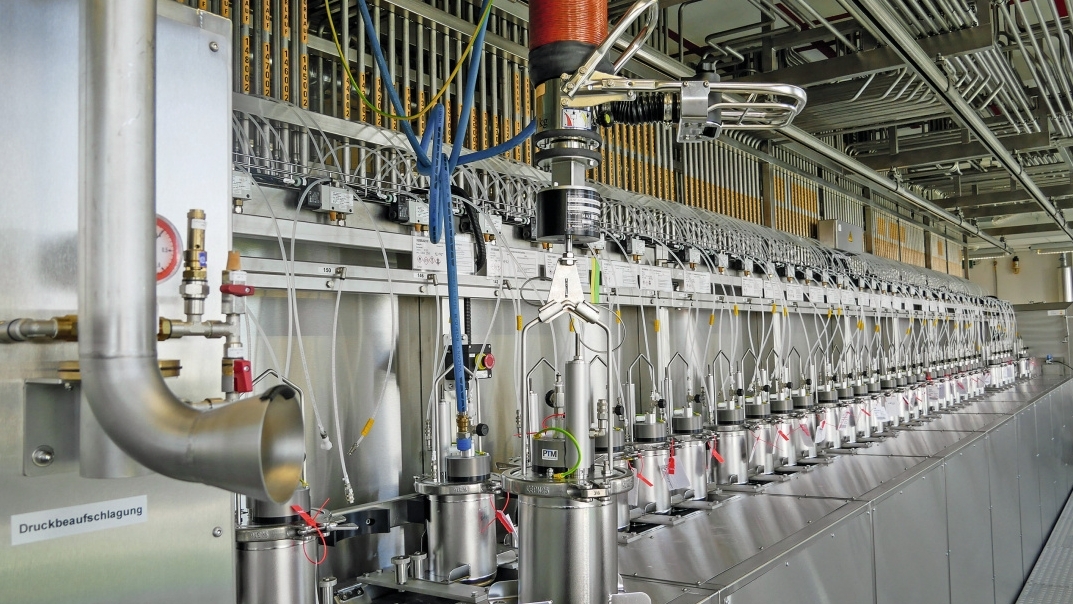BASF relies on efficient double diaphragm pumps from Timmer in its "Surface Technology" division for paint development.
With the Lean Lab, BASF has implemented a modern, modular laboratory concept for the production of automotive coatings at its Münster site. The focus here is on digitalized and transparent development processes and a high degree of resource efficiency. The laboratory offers optimal conditions to meet the growing demands of the automotive coatings market even faster and more flexibly. Solutions from Timmer GmbH play a key role in this. Around 300 double diaphragm pumps from the Neuenkirchen-based company work at the heart of the paint development process. They ensure process reliability and energy efficiency at the highest level.
The market for automotive coatings has developed extremely dynamically in recent years. Technological advances and an awareness of high-quality paints have led to a growing variety of coating options. In the course of this development, not only has the complexity of production increased, but also the demands on quality and manufacturing processes.
For this reason, and in order to make work processes even more efficient, simple and transparent, BASF has created the modular laboratory concept Lean Lab. Using special software, BASF networks all the integrated work areas of the laboratory where practical sample production takes place and, thanks to this networking, can centrally coordinate and control the entire supply of raw materials. This speeds up the work processes considerably, as the raw materials are always available at the right time and in the right place.
Process automation in paint development
In the past, the development of coatings consisted largely of manual work. Laboratory staff used pipettes to manually add certain quantities of raw materials to the overall mixture in order to produce a coating. Today, this happens to a large extent automatically. The Lean Lab uses a laboratory dosing machine specially developed for this purpose, which automates recurring work steps. In concrete terms, this means that the employees select a specific stored product at the system, the system calls up the corresponding recipe and automatically mixes the raw materials in precise proportions. This ensures that the quality of the initial mixture is consistently high.
Efficient double diaphragm pumps, in this case from Timmer GmbH, make this automation possible in the first place - they are the heart of the system and fundamental to its functionality. This is because the central raw material supply to the more than 300 dosing points available via the automatic dosing system takes place using the Timmer pumps. The materials are conveyed, dosed and regularly circulated via these pumps. BASF works with several hundred raw materials with different properties for the development of the coatings. The raw materials to be metered differ greatly in their flow behavior and the wide range of viscosities. Without constant pump performance, dosing accurate to the gram is not possible.
Space-saving and energy-efficient
BASF can pump almost all materials with these pumps. Their compact design and user-friendliness are a major advantage. Compared to conventional versions, the double diaphragm pumps are only about half the size. As BASF has several hundred pumps in use, which are installed at close intervals, the company saves a considerable amount of space. At the same time, this solution makes access easier. If certain pumps need to be inspected, they can be removed or dismantled very quickly and easily.
Another advantage: the double diaphragm pumps have a very low starting pressure. While conventional variants on the market require a starting pressure of 1.5 to 2 bar for the pump to run at all, the Timmer solution only requires 0.5 bar and works reliably at a pressure of just 1 bar. This leads to significant energy savings in the medium and long term, as less compressed air is required.
Furthermore, the pumps cannot come to a standstill. This is ensured by a special ceramic snap-action valve, which is particularly low-wear. As a rule, the diaphragm is the main wearing part of a pump - like the brake pads in a car. If the diaphragm needs to be replaced, the valve and the entire seal usually have to be replaced as well. All parts that move in the heart of the Timmer pump are made of ceramic in combination with finely ground high-performance plastics. This leads to minimal wear in the valve itself. In addition, a short-stroke principle is used, in which the diaphragm performs shorter strokes and is therefore protected. This also results in less pulsation - i.e. fewer pressure surges in the line. High pulsation can lead to distortions in the measurement of the raw material quantity. As BASF sometimes fills in the milligram range, this is an important factor. On the other hand, the Timmer solution has a so-called detent function. If the flow rate is too low, conventional pumps often stop and then do not restart on their own. With the Timmer pumps, on the other hand, BASF can pump raw materials without any problems, even in minimal quantities.
Digital networking in the Lean Lab, in which high-performance pump technologies are an important component, quickly led to the desired results: BASF was able to optimize the quality of the paint samples and use the efficiencies to increase speed for the customer.


